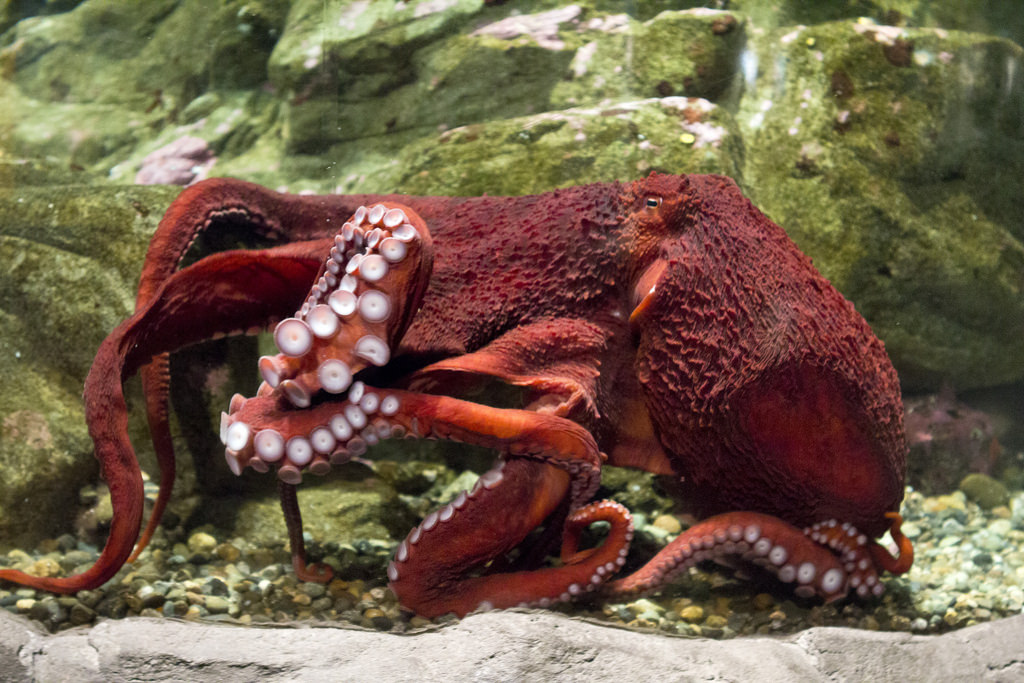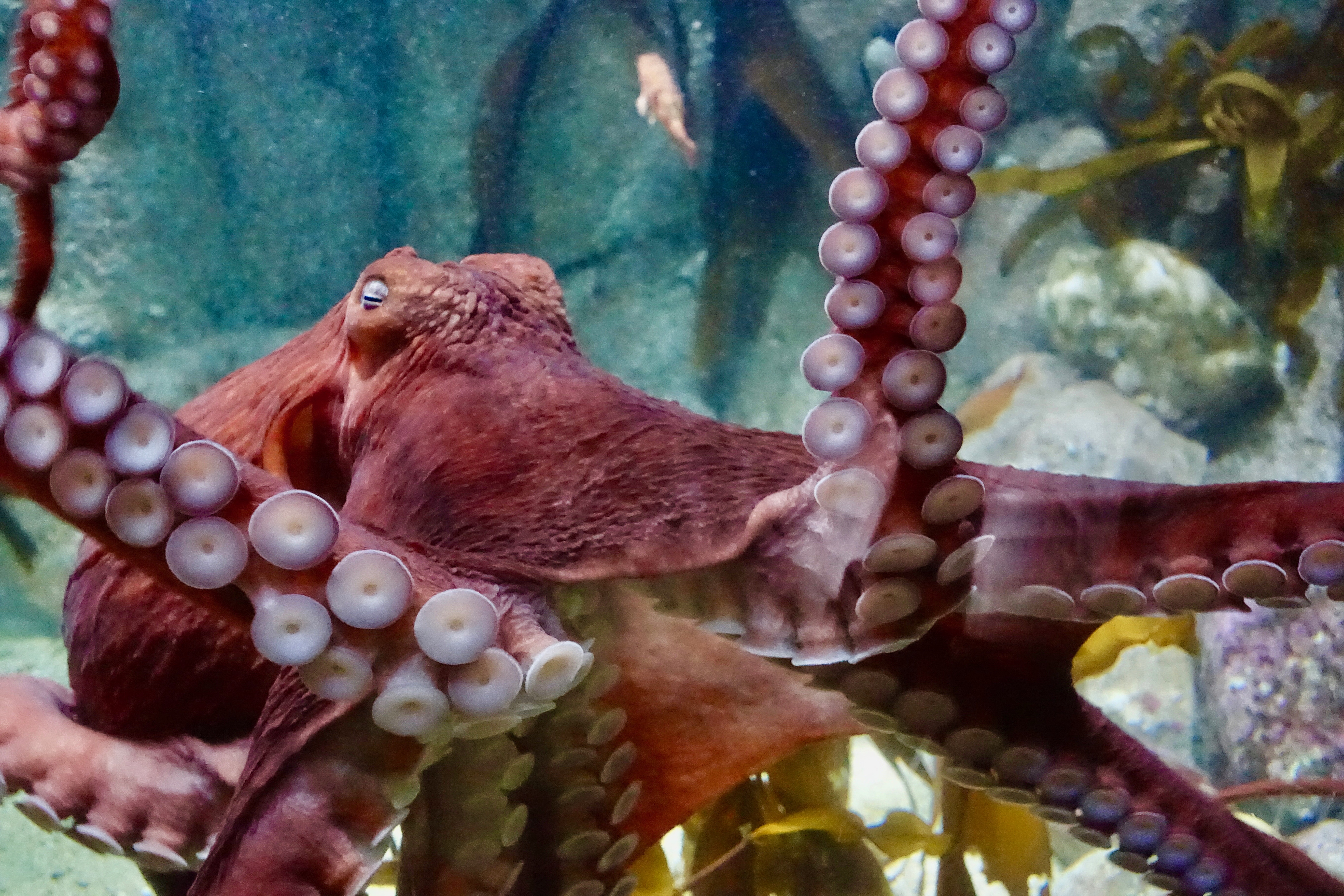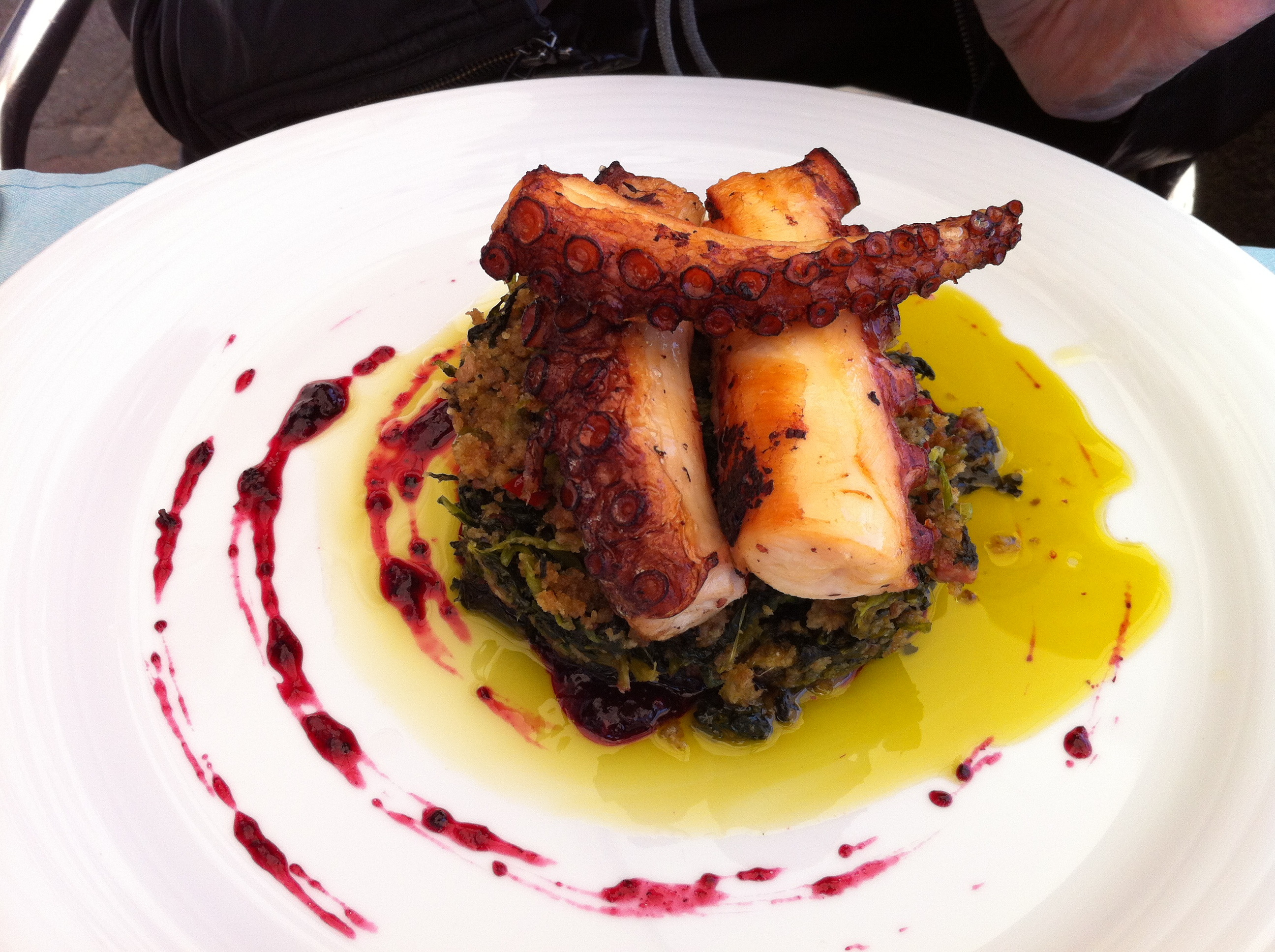Enteroctopus dofleini
North Coast (Oregon Border to Point Arena)
North Central Coast (South of Point Arena to Half Moon Bay)
Central Coast (South of Half Moon Bay to Point Conception)
Santa Barbara (Point Conception to Point Dume)
South Coast (Point Dume to Mexico border)
Firm fish
Shellfish
Wild caught

The Science

Taxonomic description
- As the largest species of octopus in the world; average weight is 50 Kg (110 lbs) and length of 5 meters (15 ft). [4]
- Has a huge, bulbous head and is generally reddish-brown in color. [4]
- Uses special pigment cells, called chromatophores [6] in its skin to change colors and textures to camouflage very well. [4]
- When threatened, it secretes ink. [14]
- Can squeeze through small spaces and only limited by the size of its beak since that is the hardest part of its body. [11]
Distribution
- Found throughout the temperate waters of the Pacific, from Southern California to Alaska, west to the Aleutian Islands and Japan. [4]
Life history
- Life span is 3-5 years [17]
- Hatches from an egg, floats to the ocean’s surface, and experiences a planktonic stage for 30-90 days. [6]
- About one percent of the planktonic larvae survive [2] because many are lost to predators [3], but once settled to the sea floor, juvenile octopuses grow rapidly and have a significantly higher survival rate. [17]
- Sexually mature at 1-2 years of age; mates in the spring [17]; males and females find each other, then use their senses of sight to determine attraction during courtship. [6]
- A male uses its ligula to place spermatophore into the female’s oviduct; entire mating process takes 3-4 hours. [6]
- Females lay 20,000 to 100,000 eggs in a den and tend to them throughout incubation (5-7 months). [17]
- After mating, males and females experience senescence (the final stage of the mating process and life cycle) during which they refuse to eat; males die within a few months after mating and females die shortly after the eggs hatch. [6]
- Predation or starvation is the usual cause of death. [6]
Habitat
- Lives in dens and caves [15] in intertidal zones to depths of 750 meters (2,500 ft). [3]
- Only the largest fish (such as halibut and ling cod) and marine mammals are any threat to adults. [3]
- Hunts at same depths in which it lives; newly hatched octopuses eat small organisms (copepods, larval crabs, and seastars); Adults feed on crabs, clams, snails, small fishes and other octopuses. [3]
- As it is generally nocturnal, it hunts at night. [11]
- The Giant Pacific octopus uses eight strong arms combined with suckers [6] to find and hold prey; it may paralyze prey such as fish with a toxic saliva, then tear into it with its parrot-like beak or simply pull the prey’s defenses apart (as with crab shells) to get at the meal within. [11]
- Humans use it as food, aquarium pets, and bait. [3]
The Fishery
Seasonal availability
- Potentially available year-round because there is no defined fishing season, and rock crab traps are set year round. [8]
Regulatory and managing authority
- As established by the Marine Life Management Act, the California Fish and Game Commission regulates the fishery, and the California Department of Fish and Wildlife manages this fishery in state waters. [19]
- As this fish is not a commercially targeted species, there are currently no formal management plans in place but this fishery is monitored. [8,13]
Gear type
- Octopi caught in commercial crab and lobster traps may be kept, but refer to the most recent regulations digest for the most up to date information. [13]
- Caught in rectangular wire lobster traps baited with fish and weighted down on the seafloor and around rocky underwater outcrops in water less than 31 m (100 ft) deep. [1]
Status of the fishery
- There is currently a lack of concern for stocks at current level of commercial exploitation. [13,15]
- Stock numbers appear healthy despite the lack of regulation. [15]
Potential ecosystem impacts
- Use of traps on the seafloor presents a risk of damage if traps are dragged or scraped on bottom, and potential entanglement of marine mammals in buoy lines. [9,10]
The Seafood

 Edible portions
Edible portions
- The arms are usually eaten, however the entire octopus is used in some recipes.
Description of meat
- Has a slightly sweet flavor and smooth, slimy texture when eaten raw. [5]
- When cooked, it retains some of its sweetness and has a meaty, crunchy texture. If undercooked or overcooked, it will be rubbery. [5,12]
Culinary uses
- Sold in a variety of forms, including fresh, frozen, dried, salted, and brined. When prepared fresh, it is often served alongside other seafood in stews, paella, and pasta dishes, but can also be prepared on its own (usually roasted or grilled). [14]
- Must be properly cleaned and sliced before it can be prepared; if the beak and head are still attached, then those parts should be removed. [12]
- If bought live, gloves are recommended since it can bite. [12]
- Long, slow cooking should always deliver tender results. The average simmering time should be about an hour for a 1lb (450g) octopus, two hours for a 4 lb (1.8kg) octopus, but that will vary. The best way to tell is to treat it like a potato: poke it with a knife and when it's ready it should feel as soft to the knife as a potato would. [12]
Nutritional information
- Octopus is lean and low in calories. [16]
- Naturally low in fat but high in cholesterol. [7,16]
- High in healthy levels of iron, selenium, and vitamin B-12. [16]
- Nutritional values are listed in table. [18]
Toxicity report
- None known.
Seasonal availability
- Available year round. [13]
References
[1] California Department of Fish and Wildlife. 2019 California Spiny Lobster, Panulirus interruptus, Enhanced Status Report. Web. https://marinespecies.wildlife.ca.gov/california-spiny-lobster/the-fishery/. Accessed 28 August 2020.
[2] My Diet Meal Planner. Fish & Seafood." Mydietmealplanner.com.. Web. 30 May 2017. <http://www.mydietmealplanner.com/mobile/nutrition-facts-label/fish-and-s....
[3] National Aquarium. Giant Pacific Octopus.. Web. 30 May 2017. https://www.aqua.org/Experience/Animal-Index/giant-pacific-octopus
[4] National Geographic Society. Giant Pacific Octopus.. Web. https://www.nationalgeographic.com/animals/invertebrates/g/giant-pacific.... Accessed 30 May 2017.
[5] Linh. Recipe Maker. 2020. What Does Octopus Taste Like? Web. https://recipemarker.com/what-does-octopus-taste-like/. Accessed 31 August 2020.
[6] Kalupa, J. "The Giant Pacific Octopus: Enteroctopus Dofleini." Bioweb.uwlax.edu. Web. 30 May 2017. http://bioweb.uwlax.edu/bio203/s2012/kalupa_juli/reproduction.htm
[7] Luther, C. "The Nutrition in Octopus." Livestrong.com. Leaf Group, 15 Dec. 2015. Web. 30 May 2017. http://www.livestrong.com/article/519496-the-nutrition-in-octopus/.
[8] Major, D. 2017. Personal Communication. San Diego Commercial Fisherman, F/V Plan B, San Diego Bay, CA.
[9] Iacchei, M., P. Robinson & K.A. Miller .2005. Direct impacts of commercial and recreational fishing on spiny lobster, Panulirus interruptus, populations at Santa Catalina Island, California, United States, New Zealand Journal of Marine and Freshwater Research. https://doi.org/10.1080/00288330.2005.9517386
[10] Monterey Bay Aquarium. 2013. Fishing Methods Fact Card: Traps and Pots. http://www.seafoodwatch.org/ocean-issues/fishing-and-farming-methods. Accessed 30 May 2017.
[11] Seattle Aquarium Octopus.". Seattle Aquarium. Web. 30 May 2017. https://www.seattleaquarium.org/animals/giant-pacific-octopus
[12] Oulton, R. Octopus. CooksInfo.com. Published 11 November 2003; revised 07 November 2007. Web. http://www.cooksinfo.com/octopus. Accessed 30 May 2017.
[13] California Department of Fish and Wildlife. 2020. 2020 California Commercial Fishing Regulations Digest. https://nrm.dfg.ca.gov/FileHandler.ashx?DocumentID=175639&inline. Accessed 31 August 2020.
[14] Schiller, L. Monterey Bay Aquarium: Giant Pacific Octopus. Monterey Bay Aquarium: Seafood Watch, 2015. PDF. https://www.seafoodwatch.org/-/m/sfw/pdf/reports/o/mba_seafoodwatch_octo.... Accessed 30 May 2017.
[15] Tank, S. State of the Catch: A Professional's Guide to Sustainable Seafood. Vancouver: David Suzuki Foundation, 2006. PDF. https://central.bac-lac.gc.ca/.item?id=StateoftheCatch&op=pdf&app=Library. Accessed 30 May 2017.
[16] Anne, M. SF Gate. The Nutrients in Octopus. 2018. Web. https://healthyeating.sfgate.com/nutrients-octopus-3006.html. Accessed 31 August 2020.
[17] Woodford, R., and K. Donohue. "Giant North Pacific Octopus." Alaska Department of Fish and Game. Alaska Department of Fish and Game. Web. http://www.adfg.alaska.gov/index.cfm?adfg=wildlifenews.view_article&arti.... Accessed 30 May 2017.
[18] Giant Pacific Octopus.Web. Nutritionvalue.org. https://www.nutritionvalue.org/Mollusks%2C_raw%2C_common%2C_octopus_nutr.... Accessed 21 September 2017.
[19] Marine Life Management Act. n.d. California Department of Fish and Wildlife. Web. https://wildlife.ca.gov/Conservation/Marine/MLMA. Accessed 24 August 2020.
[20] Shattuck, C. 2012. flickr. Rain. Giant Pacific Octopus. Male. Digital image. Web. https://www.flickr.com/photos/canopic/7882355920/. Accessed 10 February 2021.
[21] Jurvetson, S. 2019. flickr. Giant Pacific Octopus. Digital image. Web. https://www.flickr.com/photos/jurvetson/32348728957/. Accessed 10 February 2021.
[22] Schulte, R. 2016. Cool San Diego Sights. Digital image. Web. https://coolsandiegosights.com/2016/03/25/san-diego-history-world-war-ii.... Accessed 10 February 2021.
[23] Keith, J. 2013. flickr. Octopus. Digital image. Web. https://www.flickr.com/photos/adactio/8906832621/. Accessed 10 February 2021.
